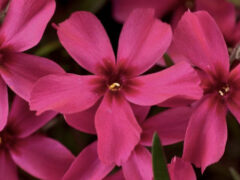
‘Red Riding Hood’ tall garden phlox
Phlox paniculata 'Red Riding Hood'
Vivid clusters of fragrant, cherry-red flowers from mid thru late summer. This compact variety attracts … Continued
 Hummingbirds, bees and butterflies are well-known pollinators, but there are thousands of unsung pollinator heroes, including moths, wasps, flies, and beetles, many mammals, birds, and reptiles, who also take on the job.
Hummingbirds, bees and butterflies are well-known pollinators, but there are thousands of unsung pollinator heroes, including moths, wasps, flies, and beetles, many mammals, birds, and reptiles, who also take on the job.
Pollinators move from plant to plant, fueling up with pollen and nectar from blooming trees, shrubs, perennials, annuals, vegetable plants, and herbs. As they move, the pollinators transport and deposit pollen, fertilizing plants and allowing them to reproduce.
Pollinator plants can be native and non-native, but not all flowering plants are equal when it comes to providing the highest quality protein-rich pollen. Many hybrids don’t even produce pollen at all. The following list includes pollen-rich plants to include in your garden to provide pollinators with food.
Local butterfly expert Lenora Larson has created these informational handouts. You can download them here!
• Butterflies: Flying Flowers in your Garden!
• A Vital Connection: Native Plants and Butterflies
• Long Lips Farm Caterpillar Foodplants
• Butterfly Bartending: Nectar Flowers
• Long Lips Farm: Selected Butterfly Nectar Flowers
• Bee Friendly: Plants for Bees and Other Pollinators
Since 1970 the population of North American birds has dropped nearly 30% — almost three billion birds have vanished from our forests, grasslands, and backyards in less than a human lifetime. It’s a chilling fact that makes it clear that we must act as individuals to help ensure their survival.
Most importantly, ninety-six percent of all terrestrial bird species rear their young on insects so it is also important to grow plants that feed insects to provide a well-rounded habitat in your garden.


Phlox paniculata 'Red Riding Hood'
Vivid clusters of fragrant, cherry-red flowers from mid thru late summer. This compact variety attracts … Continued

Phlox subulata
Showy spring perennials produce vibrant carpets of bloom in very early spring, right when we’re … Continued

Phlox divaricata
Phlox divaricata and Phlox divaricata ‘Blue Moon’ grow clusters of blue and violet five-petal stars … Continued

Phlox paniculata
Large clusters of fragrant purple blooms. Remove faded flowers to encourage more blooms. Plants grow … Continued

Physostegia virginiana
Physostegia virginiana has an upright spreading habit, this plant will requires space and should be … Continued

Pontederia cordata
A vigorous marginal aquatic perennial native to stream and pond margins. In the wild plants … Continued

Oenothera speciosa
Showy evening primrose, or pink ladies, are native to the midwest. The evening primrose common … Continued

Plectranthus 'Mona Lavender'
A vigorous, upright, bushy perennial that is primarily grown for its attractive lavender flowers which appear … Continued

Plumbago auriculata
Native to South Africa where it is an evergreen shrub that grows 6-7’ tall and … Continued
Asclepias exaltata
A shade-loving milkweed actually exists! Found in woodland openings, poke milkweed thrives in dappled to … Continued

Populus tremuloides
Best grown in rich, humusy, consistently moist, well-drained soils in full sun. In the wild, … Continued

Populus deltoides
State tree of Kansas! Broad open crown of widely spreading branches covered in lustrous, bright … Continued